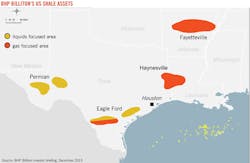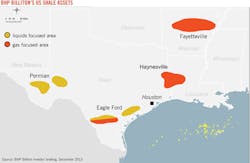BHP executive details big plans for US shale plays
HOUSTON, Tex.—Australian resource conglomerate BHP Billiton is ramping up its activity in unconventional resource plays in the US. Since entering the US shale business 3 years ago, the company has grown into one of the top producers in the Eagle Ford shale. It also holds sizable positions in the Permian basin and Fayetteville and Haynesville shales.
Speaking to a press briefing in Houston, Tim Cutt, president of BHP's Petroleum and Potash business, said: "The shales we're in happen to all be within about 500 miles of [Houston], so a lot of our business if shifting right here."
Most of the company's US shale budget is focused on the liquids-rich Eagle Ford. In the fiscal year 2014, which starts on Jul. 1 for BHP, more than $3 billion of the company's $3.9 billion capital spending budget for the US onshore will be dedicated to the booming South Texas shale play.
BHP currently produces more than 100,000 boe/d from the Eagle Ford, and drilling is focused on the liquids-rich Black Hawk development area. Of the 26 operated rigs the company is running across the onshore US, 15 are in the Black Hawk area. BHP's second focus area is in the play's Hawkville field, where five rigs are active in the condensate-rich area. There remaining rig is in the Haynesville shale.
Like many operators, BHP is working to reduce drilling and completion costs in the Eagle Ford area by optimizing drilling and improving logistics. During the past 12 months the cost of drilling an Eagle Ford well has declined 20% to $4 million from $5 million.
Lower costs are not the only area of focus for BHP. The company is also keen on optimizing its completion techniques and improving hydrocarbon recovery from each of its wells. Cutt said BHP is experimenting with different techniques for determining the optimal spacing of its wells, finding the best placement of its laterals within the reservoir, and improving its hydraulic fracturing process.
"We can actually do 3D models from microseimic where we're actually seeing, during the fracture, we can actually model, through sensors on the surface, where the fracture is opening up," he said. Tracers are pumped down into the reservoir with the frac fluid, enabling the company to monitor sand and fluid movement.
"When you look at that you can start seeing these big sections of the wellbore in the matrix that are not being attacked." Cutt said the most successful producers will be the companies that get the best frac, get the proppant to the right spots, and have the proppant hold over time.
BHP's efforts are paying off. Cutt said experiments with enhanced fracing techniques are producing uplifts of 10-50% in the estimated ultimate recovery of Eagle Ford wells.
The South Texas Pearsall shale is also being explored. BHP drilled its first well in the formation in October 2013 and holds 30,000 net acres in the play. Cutt said the company is months away from determining the commerciality of the play and declined to share initial well results, citing ongoing land acquisition efforts.
BHP is also increasing its presence in the oil-rich Permian basin in West Texas, where it has amassed 500,000 net acres. Cutt said the Bone Springs and Wolfcamp shales are key horizons, along with a 100,000 net acre area in the Delaware subbasin.
"We're getting encouraged in the Permian and are looking to go into full-scale development there in the next fiscal year," Cutt said.
Like most US operators, BHP is concentrating on areas rich in oil and natural gas liquids. The prolonged weakness of US natural gas prices has led the company to temporarily suspend its operated drilling program in the dry gas-rich Fayetteville shale in Arkansas, though it is still funding its portion of a Fayetteville drilling program operated by partner Southwestern Energy.
"They are absolutely in the sweet spot of the Fayetteville, and the economics are good," Cutt said.
BHP is also operating five rigs in the gas-rich Haynesville shale in North Louisiana and Northeast Texas where the company needs to finish getting acreage held by production.
The company's growing presence in US shale is mirrored by its growing presence in Houston.
BHP is expanding its US workforce and recently broke ground on a 30-story office tower in Houston. Cutt said the company had 700-800 employees working in the city in early 2011, when it made its initial foray into US shale.
"We have now 2,000 people in Houston, and that's about half of our workforce globally," Cutt said.

